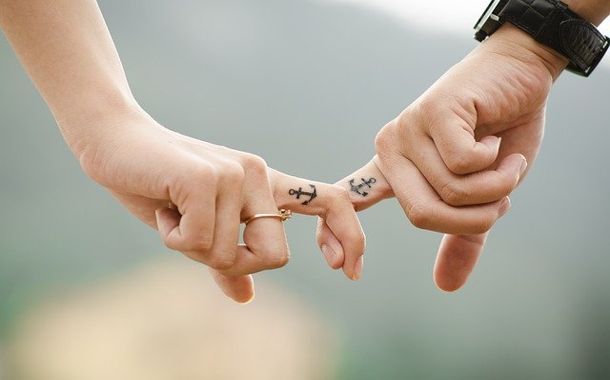How Much Does a Finger Tattoo Cost?
Last Updated on April 25, 2024
Written by CPA Alec Pow | Content Reviewed by ![]() CFA Alexander Popinker
CFA Alexander Popinker
Finger tattoos have become an increasingly popular ink option, especially for first-timers seeking a delicate design. But unlike getting tattooed on other body parts, finger tattoos require careful consideration due to their high visibility and the intricacy involved in tattooing their petite canvas.
With less room for error on small-finger real estate, finding an artist skilled in precision work is essential for quality results.
While cheaper and quicker to get than a full sleeve or back piece, high-quality and durable finger tattoos that stand the test of time still require a financial investment.
In this article, we’ll break down the many factors that influence finger tattoo costs, including design intricacy, color choices, tattooist skill level, and studio reputation. You’ll learn what realistic pricing looks like based on finger tattoo type and get tips for selecting the right artist.
We’ll also discuss the pain levels, longevity, and aftercare required so you can weigh the pros and cons before taking the plunge into getting your first finger ink.
How Much Does a Finger Tattoo Cost?
For a finger tattoo, costs typically range from $50 to $500 or more, depending on the complexity of the design and the expertise of the artist.
Due to the many factors influencing each unique design, finger tattoo costs can vary widely. However, as a general rule of thumb, you can expect to pay:
- $50 – $150 for very simple designs – typically single-color minimalist text, logos, geometric shapes, or micro-sized symbols. Placement is limited to a single finger.
- $150 – $300 for moderately complex blackwork designs – usually spanning multiple fingers with more elaborate patterns and detailing involved.
- $300 – $500 for colorful multi-finger coverage – any tattoo that uses multiple colors, contours the finger or covers a wide surface area of the hand. Custom artistry required.
- $500+ for advanced full finger or knuckle designs – this represents the top tier for hand and finger tattoos. Covering the knuckles or entire surface of multiple fingers in detailed, vivid artwork that demands an expert touch.
Pricing on the higher end usually occurs in major metropolis like New York City or Los Angeles given elevated shop costs. Quotes ultimately depend on the unique design, placement, use of color, and artist’s rates.
According to Removery, a finger or hand tattoo can start at $50 for something very simple and go up to $300 for more elaborate designs.
Tatt2Away also reports that finger or hand tattoos can start as low as $50 for basic designs and go up to $300 for more complex ones,
Derm Dude mentions that finger tattoos can start at $50 for small designs and go up to $150 for more detailed ones.
The Rising Popularity of Finger Tattoos
Thanks in part to celebrity influence and social media exposure, dainty minimalist finger tattoos have grown wildly popular in recent years as a means of subtly expressing oneself through body art.
Their delicate nature provides an intriguing way for tattoo newbies to dip their toe into getting inked for the very first time. The finger offers a relatively small surface area to decorate with a meaningful design while still remaining low-key.
But while their pint-size may seem enticing, getting a finger tattoo still represents a permanent body modification and financial commitment requiring careful thought – even more so than other body parts.
The extreme visibility of finger tattoos also necessitates consideration of potential future lifestyle implications and professional constraints. But when done thoughtfully by a talented and steady-handed tattoo artist using quality tools and inks, finger tattoos can be an alluring and expressive option for the right individual.
Factors Affecting Finger Tattoo Pricing
Several important elements affect the costs associated with getting finger tattoos:
Design Complexity and Customization – Typically, the more intricate the detail involved in a tattoo artwork and the more custom craftsmanship required by the artist, the higher the pricing, as complex work takes substantially more time, skill, and effort compared to basic designs.
Complex patterns, textures, geometric shapes, and photorealistic portraiture cost more than standard lettering or shapes. Custom one-of-a-kind drawn designs are also usually more expensive than pre-selected flash tattoos.
You might also like our articles about the cost of a word tattoo, a knuckle tattoo, or an armband tattoo.
Color – Each additional color used in a tattoo tends to incrementally add to the overall cost. Pricing takes into account the extra time, tools, inks, and blending expertise needed for color saturation and vibrancy compared to black linework alone.
Size and Placement – The amount of skin surface area and number of fingers the design spans will impact cost, similar to sizing in other tattoo genres. A design wrapping around the entire finger typically costs more than one isolated on a single finger. Extended digit coverage heightens complexity.
Tattoo Artist Skill and Experience – Given the extremely fine detail work and precision needed for quality finger tattoos, artists with greater expertise in smaller designs rightfully earn higher rates. Their advanced skills and years spent honing their technique warrants charging a premium for inking such an unforgiving intimate canvas.
Studio Reputation and Location – Exclusive high-end tattoo shops with top artists in major metro downtowns like New York City or Los Angeles command more for overhead costs than independent local studios in smaller towns. Location’s cost of living and competitive market rates influence pricing.
Now that we’ve outlined the primary elements that impact quote variability, let’s examine some ballpark figures for what finger tattoos realistically cost.
Additional Potential Costs
Aside from the actual inking session, you’ll want to anticipate any of these supplementary expenses that may arise:
Touch-Ups – Since finger tattoos are prone to fading quickly, most clients need periodic touch-ups over time to maintain vibrancy. Plan around $50 per 15–30-minute session.
Aftercare Products – Quality tattoo healing ointments, gentle soaps, moisturizers, and sun protection add to the results. Allocate $25-50 for recommended products.
Tipping – Tipping your tattoo artist 15-25% or more on top of the total cost is customary for excellent service and results.
Future Removal – If regret sets in later, laser removal for finger tattoos costs approximately $50-150 per fade session.
Accounting for subsequent touch-ups and proper aftercare is essential to ensure your finger tattoo lasts and heals optimally.
Choosing the Right Finger Tattoo Artist
Since quality finger tattoos demand next-level precision and expertise, do your due diligence in finding the perfect artist for your vision. Be sure to:
- Scrutinize their portfolio and client testimonials – do they have demonstrated experience creating small, intricately detailed designs? This predicts the outcome you can expect.
- Visit the studio in person to assess the overall professionalism, technique, sterile practices, and vibe. This gives more insight than an online gallery.
- Ask detailed questions about their specific tools, sterilization standards, inks used, and other safety practices. Reputable artists will eagerly provide transparency.
- Get quotes from 3+ artists you’re considering to compare pricing and comfort levels. Go with the one aligned with your style and budget needs.
Putting in the time to properly vet artists and consultations prevents regrets and ensures the ideal render of your meaningful finger tattoo.
Pain Level and Healing Expectations
Due to dense nerve endings and extremely thin skin, finger tattoos are regarded as substantially more painful than other common body areas. The intensity is greater but dissipates quicker given the petite canvas. Typical post-tattoo healing of a finger tattoo involves:
First 1-2 Weeks: Maximum soreness, swelling, bruising, and scabbing occur during the initial mending phase. Carefully washing while avoiding water submersion is key.
2-4 Weeks: Itching sets in as the epidermis regenerates and sheds. Light peeling of the excess ink/plasma is normal. Apply ointment 1-3 times daily for comfort.
1-2 Months: Once scabs fully shed, the tattooed design is revealed but still requires a bit longer to reach maximum vibrancy as deeper layers continue healing.
Closely following your tattoo artist’s aftercare directions optimizes results and prevents infections or fading.
Long-Term Considerations
 While aesthetic when new, also weigh these critical permanency factors:
While aesthetic when new, also weigh these critical permanency factors:
- Fading will occur more rapidly on highly mobile finger skin than other body parts. Periodic touch-ups help offset this.
- Visible hand and finger placements mean your design may hinder certain career options or violate occupational dress codes. Choose wisely.
- Aesthetics and trends constantly evolve. The novelty may wane over time. Ensure your piece carries enduring meaning.
Make certain you can commit to lifetime visibility, care, and intermittent touch-ups. Laser removal is an option later if necessary.
Legal and Age Considerations
The laws regarding finger tattoos fall under the same regulations as tattoos elsewhere on the body. Some rules include:
- You must typically be at least 18 years old in the United States to get tattooed without additional parental approval and presence. Always confirm your specific state or region’s age laws.
- Government-issued photo ID such as a driver’s license is required upon arrival at all professional studios to validate your age. No exceptions.
- Certain professions restrict visible tattoos including on fingers and hands. Verify your employer’s policies to avoid issues.
Following proper protocols keeps you safe and legally compliant. Never sacrifice quality by using amateur artists willing to tattoo minors.
Final Words
Thanks to their delicate nature, minimalist aesthetic, and trendy celebrity appeal, finger tattoos can seem like the perfect introductory foray into getting your first tattoo. But the decision to get inked on one of the most visible and unforgiving locations – one that demands extra precision work – warrants deep reflection beforehand on the pain level, aftercare, longevity, and lifestyle impacts.
The bottom line is finger tattoos undeniably make alluring and personal additions when done thoughtfully by a talented artist on the right individual willing to accommodate the inherent costs, discomfort, visibility, and care involved.
But impulse decisions or budget designs often lead to regret down the line. Weigh whether you’re ready for a lifetime commitment prior to taking the plunge. Then you can enjoy this intimate form of self-expression without reservations.
Frequently Asked Questions
How long will finger tattoos last?
With proper aftercare, finger tattoos can remain vibrant for 1-5 years, often fading sooner than other body parts. But due to heavy hand use, you should expect to need periodic touch-ups every 12-24 months long-term to maintain your design.
What to expect when getting a finger tattoo?
You can expect some intensity and discomfort given the high nerve concentration in the finger. The process involves cleaning the skin, placing the stencil, and slow meticulous application of the ink. Try to avoid washing hands or submerging them immediately afterwards to let scabbing occur.
When can I wash my finger tattoo?
Gentle hand-washing without direct water pressure can generally begin about 24 hours after getting your finger tattoo, once the initial protective plasma, ink and blood soak into the dermis surface. But avoid prolonged hand submersion in water during the first 10-14 days until scabbing has fully cleared. Apply ointment 1-3 times daily during healing.


Leave a Reply
Want to join the discussion?Feel free to contribute!